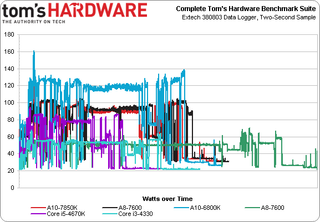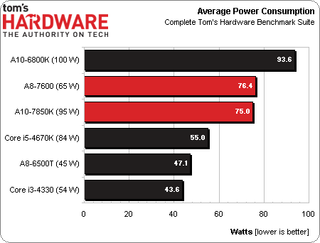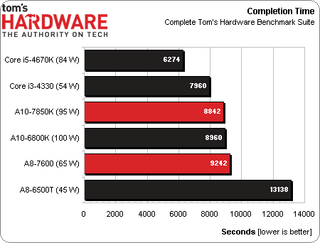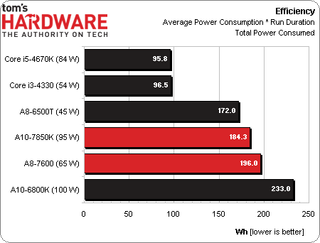AMD A10-7850K And A8-7600: Kaveri Gives Us A Taste Of HSA
We've spent the days following CES benchmarking two of AMD's new Kaveri-based APUs. Do the Steamroller x86 architecture, GCN graphics design, and HSA-oriented features impress, or do they come up short against Intel's value-oriented Haswell-based parts?
Results: Power Consumption And Efficiency
I’d argue that this stuff is more fun than the actual performance benchmarks. We get to see how quickly each processor cruises through our suite, we measure instantaneous power consumption along the way, and then we're able to calculate what that data means to overall efficiency in the tests we’re running.

The line chart is admittedly messy, but it shows you that there’s actually something being logged as our benchmarks run. Each platform has 30 minutes of idle time inserted at the end of the suite, where we record power on the Windows desktop, just to ensure we’re not exclusively reporting results under load.
The outlier is AMD’s 45 W A8-6500T, which maintains remarkably low power draw through our workloads, but takes a long time to finish up. It’s a bold strategy, Cotton. Let’s see if it pays off in the efficiency chart.
Hidden under all of those lines, the A10-7850K (red) and A8-7600 (black) track very closely throughout the scripted sequence, even though one is a 95 W part and the other has a 65 W TDP. I went back and re-ran the -7600 using Disabled, 65 W, and 45 W options in ASRock’s Configurable TDP firmware setting, verifying that this feature works as it should.

Averaging power consumption confirms that the Kaveri-based parts end up really, really close to each other. Given the A10-6800K’s average use almost 20 W higher, the -7850K doesn’t appear to exploit all of its power budget to max out performance.
Both the Core i5-4670K and Core i3-4330 average lower power consumption through the Tom’s Hardware benchmark suite. Now we want to know how long each processor takes to finish the job.

Those same Intel CPUs end up being the first- and second-fastest through our benchmarks.
Stay on the Cutting Edge
Join the experts who read Tom's Hardware for the inside track on enthusiast PC tech news — and have for over 25 years. We'll send breaking news and in-depth reviews of CPUs, GPUs, AI, maker hardware and more straight to your inbox.
We can’t script the game tests, so 3D performance isn’t a component in these charts. You’re seeing the result of content creation, media encoding, productivity, and compression workloads. Any time you fold in gaming and compare AMD's Radeon R7 engine to HD Graphics 4600, the Kaveri design wins consistently. Whether or not an APU can deliver the frame rate, detail setting, and resolution you want to use is another matter entirely. Still, context is important here because Steamroller just doesn’t do much for the high end of Kaveri as it exists today. There’s a lot more to like at lower power levels when you compare inside of AMD’s portfolio. But once you add low-power Core i3s to the mix, again, Intel comes out on top.

Multiply power consumption across the duration of our test suite and this is what you get. The flagship A10-7850K is notably more efficient than the Richland-based A10-6800K, partly because it’s a little faster, but mostly as a result of lower power use. That doesn’t stop the $140 Core i3 from burning close to 50% of the A10’s energy, though.
Current page: Results: Power Consumption And Efficiency
Prev Page Results: Media Encoding Next Page Hoping The Best Is Yet To Come-
Someone Somewhere Yeah, almost all the diagrams refer to the 4760K.Reply
Given that AM3+ looks like it's done, it would have been nice to see a 6-core chip. Still, one of these may end up in my next laptop. -
spp85 A10-7850k is slower than A10-6800K ?? WTF. Its all hype than actual performance to the table. Even on OpenCL GPU accelerated apps doesn't have any advantage with A10-7850k over i5 or sometimes i3 CPUs. Hopeless is what I feel about AMD CPUs.Reply -
Someone Somewhere Reply12454254 said:A10-7850k is slower than A10-6800K ?? WTF.
I got the opposite impression. Which graph are you looking at? -
Jaroslav Jandek Thank you for the article (especially the power consumption measurements), Chris. It is definitely an improvement over Richland but kind of boring (disappointingly expectable).Reply
I really like where AMD is going (HSA, GCN and TrueAudio).Too bad the manufacturing process of GlobalFoundries just can't match Intel's.
Also, it would be interesting to see the new Bay Trail Pentium or Celeron CPUs (whichever is closer in performance) in the Efficiency graphs. -
Someone Somewhere I'm fairly sure that this is on TSMC's 28nm node. GlobalFoundries can't do that yet; this is on the same process used for AMD GPUs currently.Reply -
Jaroslav Jandek Reply
28nm SHP from GlobalFoundries. AMD bought over $1 billion worth of wafers from them in december...12454280 said:I'm fairly sure that this is on TSMC's 28nm node. GlobalFoundries can't do that yet; this is on the same process used for AMD GPUs currently.
I guess you have been reading the articles from a year ago about AMD still using TSMC despite promises of GlobalFoundries' new 28nm SHP process. -
jacobian I don't really believe into the whole HSA smoke-screen. By the time HSA-enabled apps take off, you will be ready to upgrade from your CPU again. The one terrible truth that stands out right now is that at current prices, the flagship Kaveri A10 doesn't make any sense whatsoever. Kaveri A8? Maybe. Richland A10-6790K? Perhaps. But the Kaveri A10 at $180 is a just a joke, specially after all that hype.Reply -
Someone Somewhere CPUs are usually released at ridiculous prices, and come down over a month or two.Reply
Most Popular


